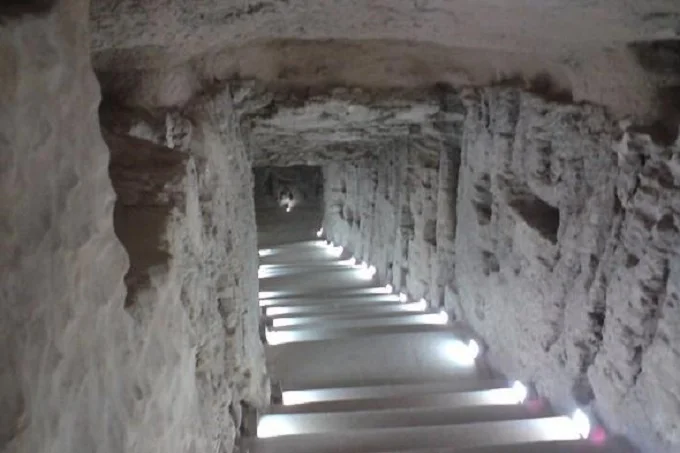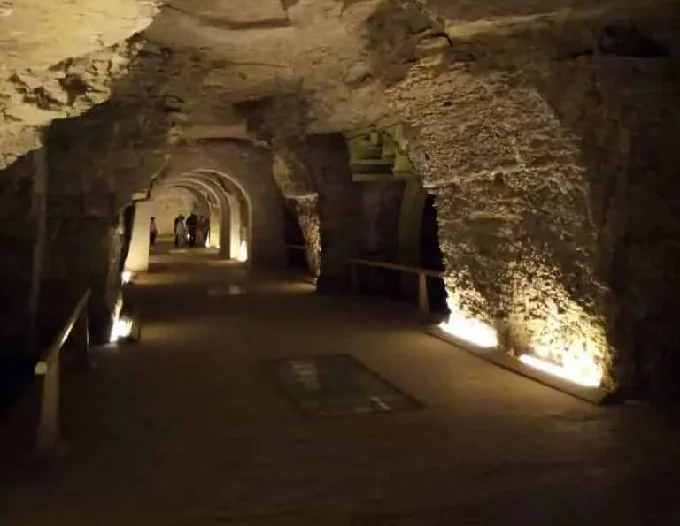What is the mystery of the Serapeum of Saqqara?

The image of gods with “animal” heads and a human body is one of the Egyptian mysteries that have not been solved to this day. For a long time, scientists considered these mythological creatures to be just a figment of the imagination of ancient artists and sculptors.
But, probably, a more thorough study of the mysterious sarcophagi found in the “bull” necropolis of the sacred Hapi in Saqqara will be able to completely refute this hypothesis.
Without the right to rebirth
The mythology of Ancient Egypt is unique, and this is emphasized by all the scientists who studied it. At the same time, the main pyramids in Giza, clearly oriented to the cardinal directions, have always been of the greatest interest to them.
For example, researchers have always had a lot of questions about the fact that the ventilation shafts in the pyramid of Cheops are directed at stars such as Sirius, Alpha Draconis, and Zeta Orion. And now, one after another, timid assumptions began to appear that aliens who colonized our planet allegedly descended from these stars to Earth in immemorial times.
The reason for such statements was the fact that this event is described in many ancient sacred texts. And wherever their authors lived — in Africa, in the Far East, or in Mesoamerica, they all tell about the same story about the conquest of the then young civilization of earthlings by some “gods” who descended from heaven.

After studying these sacred texts, some researchers have suggested that the ancient gods were quite real and looked something like they are depicted on ancient Egyptian frescoes.
However, only the discovery of ancient burials with the remains of such creatures would allow this version to move from the category of near-scientific hypotheses to the category of confirmed facts.
But what do the pyramids of Giza have to do with it, which are not known today except by younger preschoolers? Despite the fact that just 20 kilometers away from them, scientists have discovered an ancient burial underground with the remains of unusual creatures, which, according to some scientists, may well be of extraterrestrial origin.
Tomb of the Sacred Hapi
This burial is located in Saqqara, in one of the southern suburbs of Cairo, where the main necropolis of Memphis was located several millennia ago.
This place got its name, not by chance. Saqqara is a derivative word from one of the names of the god Ptah – Sokar. There are pyramids, mastabas, as well as many other graves of representatives of the ancient Egyptian aristocracy. But the most amazing find was the discovery of a necropolis built specifically for the sacred Hapi bulls.
It should be noted here that bulls, in fact, were not among the main Egyptian pantheon of deities. But one day, if you believe the myths, the god Ptah came down to Earth and turned into a bull. And this was enough for this animal to become sacred.
Black bulls with a white crescent mark on their foreheads, considered to be carriers of the divine essence of Ptah, were kept at the temple. When they left this world, they were transferred to a specially built for this purpose “bull” necropolis, where they were buried with honors, which were awarded, perhaps, only the highest nobility and pharaohs.
The discoverer of this underground structure was the French Egyptologist Auguste Mariette, who, at the end of 1850, near the step pyramid of Djoser, suddenly noticed a stone head sticking out of the sand. The scientist decided to excavate the torso of the statue and soon discovered that his find was the sphinx – a mythical creature with a lion’s body and a human head, which was described in Greek legends and chronicles.
So, Strabo claimed that somewhere in Egypt, there is a majestic temple called the Serapeum, the path to which is indicated by the alley of sphinxes. And although by the middle of the 19th century A.D., the story of the ancient Greek geographer was considered only a legend, Mariet was sure that Strabo was telling the truth.
In the course of subsequent excavations, an alley of 140 sphinxes was indeed discovered. It led to an underground temple, which the Egyptians in ancient times used as a necropolis for sacred Hapi.
Mysterious sarcophagi
The Serapeum is a room about 200 meters long, cut into the rock. Wooden sarcophagi with the remains of sacred bulls were found in several branches running from the main corridor. Each of them indicated the dates of the animal’s life and the time of which pharaoh and the high priest they fell.
But the main mystery for the researchers was the granite sarcophagi found in the center of the room. The weight of each of these 24 stone structures with polished faces reached 60 tons. And yet they were all empty.

From the point of view of logic, it was somehow wrong. Why did the ancient Egyptians need to build additional corridors for the resting of Hapi? Wouldn’t it be easier to place the remains of sacred bulls in stone sarcophagi, which are both stronger and more durable than wooden ones?
Instead, people have been burying sacred bulls inside galleries for 1600 years, rather than in more ancient stone sarcophagus, which were supposedly built during the first dynasties.
Only later did the researchers find out that these sarcophagi were not empty at all. If the discoverer of the Hapi necropolis, Auguste Mariette, had compared the external and internal dimensions of these structures, he would have realized that most of the cavity in them was filled with bitumen mixed with the ground bones of certain creatures.
One of the founders of the theory of paleocontact, Erich von Daniken, put forward an unusual version of who the bones could belong to, which the ancient Egyptians crushed almost into dust. The researcher suggested that this was due to the beliefs of the inhabitants of Ancient Egypt, who believed that any creature turned into a mummy comes to life under certain circumstances. But only on one condition: if his body remains intact, otherwise, the soul will not be able to move into him again.
Many supporters of paleocontact suggest that the Serapeum was not built by people at all, but by the very “gods” who descended from heaven or, simply put, aliens from Outer Space. According to another version, the creatures that the Egyptians worshiped as gods were representatives of the earthly, but had already disappeared from antediluvian civilization by this time.
And although even in the most ancient Egyptian manuscripts, there is no description of their appearance, it can be assumed that these very “deities” looked quite frightening.
And when they rested forever in an underground tomb, the ancient Egyptians, out of fear that the monstrous “gods” might come to life, crushed their bones into dust and mixed them with bitumen. Just like that, just in case, as they say, out of harm’s way.
The hypothesis expressed by the supporters of paleocontact currently seems to be something like a science fiction novel. But at the moment, researchers simply have no other explanation for why the ancient Egyptians suddenly needed to grind the bones of certain creatures and, mixed with bitumen, put them in granite sarcophagi.
Perhaps the discovery of new ancient burials like the tomb of the sacred Hapi in Saqqara will be able to shed light on this mystery, which has been going on for thousands of years and scientists have not yet managed to get close to solving it.




